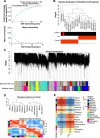Exosome miR-4738-3p-mediated regulation of COL1A2 through the NF-κB and inflammation signaling pathway alleviates osteoarthritis low-grade inflammation symptoms
- PMID: 38059912
- PMCID: PMC11088901
- DOI: 10.17305/bb.2023.9921
Exosome miR-4738-3p-mediated regulation of COL1A2 through the NF-κB and inflammation signaling pathway alleviates osteoarthritis low-grade inflammation symptoms
Abstract
This study aimed to elucidate the roles of microRNA (miR)-4738-3p and the collagen type I alpha 2 chain (COL1A2) gene in the pathogenesis of osteoarthritis (OA) through bioinformatics analysis and cellular assays. The GSE55235 dataset was analyzed using the weighted gene co-expression network analysis (WGCNA) method to identify gene modules associated with OA. Key overlapping genes were identified from these modules and the GSE55235-differential expressed genes (DEGs). The expression levels of selected genes were determined in C28/I2 cells using the quantitative real-time polymerase chain reaction (qRT-PCR). The interaction between miR-4738-3p and COL1A2 was examined in the context of interleukin 1 beta (IL-1β) induction. Exosome characterization was achieved through transmission electron microscopy (TEM), western blotting (WB), and other analyses. The study also investigated the functional relevance of miR-4738-3p in OA pathology through various molecular and cellular assays. Our findings revealed that the green module exhibited a strong correlation with the OA phenotype in the GSE55235 dataset, with COL1A2 emerging as a hub gene and miR-4738-3p as its key downstream target. IL-1β induction suggested that COL1A2 is involved in inflammation and apoptosis, while miR-4738-3p appeared to play an antagonistic role. The analysis of exosomes underscored the significance of miR-4738-3p in cellular communication, with an enhanced level of exo-miR-4738-3p antagonizing IL-1β-induced inflammation and promoting cell survival. Conversely, a reduction in exo-miR-4738-3p led to increased cell damage. This study established a clear regulatory relationship between miR-4738-3p and COL1A2, with the nuclear factor kappa B (NF-κB) signaling pathway playing a central role in this regulation. The miR-4738-3p significantly influences the OA-associated inflammation, primarily through modulation of COL1A2 and the NF-κB pathway. Therefore, targeting miR-4738-3p offers a potential therapeutic approach for OA, with exosome miR-4738-3p presenting a promising strategy.
Conflict of interest statement
Conflicts of interest: Authors declare no conflicts of interest.
Figures








References
-
- Yao Q, Wu X, Tao C, Gong W, Chen M, Qu M, et al. Osteoarthritis: pathogenic signaling pathways and therapeutic targets. Signal Transduct Target Ther. 2023;8(1):56. https://doi.org/10.1038/s41392-023-01330-w. - PMC - PubMed
-
- Bhatia D, Bejarano T, Novo M. Current interventions in the management of knee osteoarthritis. J Pharm Bioallied Sci. 2013;5(1):30. https://doi.org/10.4103/0975-7406.106561. - PMC - PubMed
-
- Steinmetz JD, Culbreth GT, Haile LM, Rafferty Q, Lo J, Fukutaki KG, et al. Global, regional, and national burden of osteoarthritis, 1990–2020 and projections to 2050: a systematic analysis for the Global Burden of Disease Study 2021. Lancet Rheumatol. 2023;5(9):e508–e22. https://doi.org/10.1016/S2665-9913(23)00163-7. - PMC - PubMed
-
- Hawker GA. Osteoarthritis is a serious disease. Clin Exp Rheumatol. 2019;37 Suppl 120(5):3–6. PMID: 31621562. - PubMed
-
- Dima R, Francio VT, Towery C, Davani S. Review of literature on low-level laser therapy benefits for nonpharmacological pain control in chronic pain and osteoarthritis. Trials. 2017;5:6. PMID: 28987080. - PubMed
Publication types
MeSH terms
Substances
LinkOut - more resources
Full Text Sources
Medical
Molecular Biology Databases
Miscellaneous

